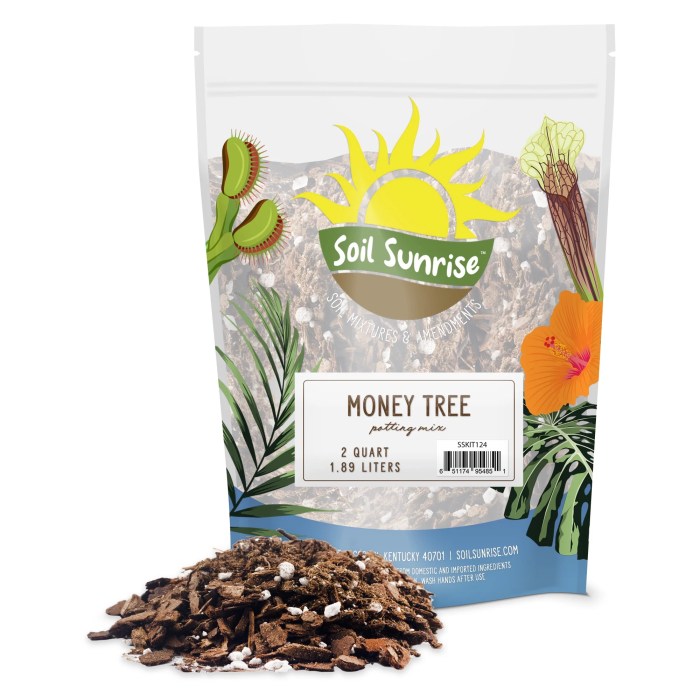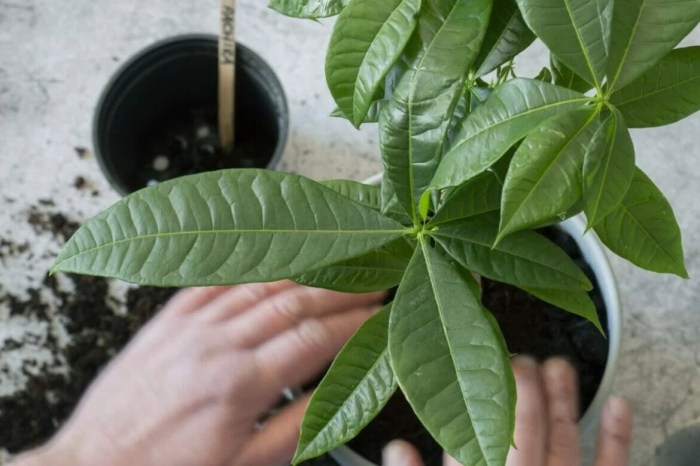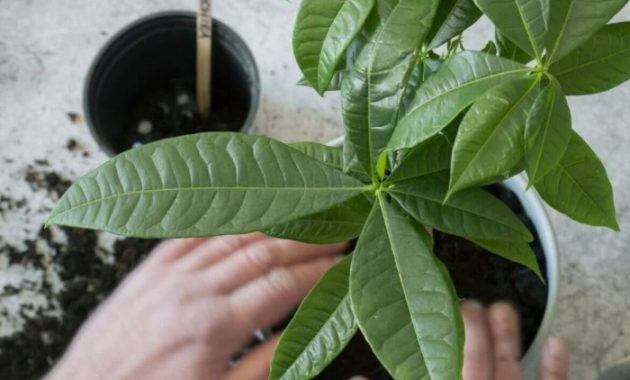Ideal Soil Composition for Money Trees
Soil for money tree plant – Money trees, scientifically known asPachira aquatica*, thrive in well-draining soil that mimics their natural swampy habitat. Understanding the ideal soil composition is crucial for preventing common problems like root rot and ensuring healthy, vigorous growth. This involves carefully considering the balance of sand, silt, and clay, as well as the soil’s pH level.
Optimal Soil Texture for Money Trees
The perfect soil for a money tree isn’t a single, rigid formula, but rather a balance that prioritizes drainage. While a loam soil – a mixture of sand, silt, and clay – is often recommended, the key is to avoid heavy clay soils that retain too much water. A good starting point would be a mix leaning more towards sandy loam, providing excellent drainage while still retaining some moisture and nutrients.
Well-draining soil is crucial for a thriving money tree, preventing root rot. Choosing the right soil is just as important as selecting the right tree for your landscape; for broader advice, check out this guide on the best trees to plant in your backyard to see what thrives in your area. Remember, even with the perfect backyard tree selection, your money tree’s soil needs remain paramount for its health and prosperity.
Too much clay will lead to waterlogging, suffocating the roots and causing rot. Conversely, pure sand offers poor water retention, leading to frequent watering and the risk of drying out the roots. The ideal blend should allow water to drain quickly, preventing waterlogged conditions that encourage fungal growth and root decay.
Soil Drainage and Root Rot Prevention, Soil for money tree plant
Proper drainage is paramount for money tree health. Root rot, a devastating fungal disease, is often a consequence of poorly draining soil. Symptoms include yellowing leaves, wilting, and ultimately, plant death. To prevent this, ensure your chosen soil mix allows for excellent aeration and water percolation. Adding perlite, vermiculite, or coarse sand to your potting mix can significantly improve drainage.
These materials increase the porosity of the soil, allowing excess water to escape easily. Consider using a pot with drainage holes to further facilitate water drainage and avoid standing water in the pot’s saucer.
Soil pH and Nutrient Uptake
Money trees prefer a slightly acidic to neutral soil pH, ideally between 6.0 and 7.0. At lower pH levels (more acidic), certain essential nutrients, like phosphorus and molybdenum, can become less available to the plant, hindering growth. Conversely, at higher pH levels (more alkaline), the availability of iron and manganese can decrease, leading to nutrient deficiencies and chlorosis (yellowing of leaves).
Regular soil testing can help you monitor the pH and make adjustments as needed, using soil acidifiers or lime to bring the pH within the optimal range.
Potting Mix vs. Garden Soil
While garden soil might seem like a readily available option, it’s generally not recommended for money trees. Garden soil often lacks the proper drainage and aeration needed, and can contain harmful pathogens or pests. Potting mixes, specifically those formulated for indoor plants, are designed with excellent drainage and aeration in mind, often incorporating components like peat moss, perlite, and vermiculite.
These mixes offer a consistent and controlled environment for root development, minimizing the risk of root rot and ensuring optimal growth.
Comparison of Soil Types for Money Trees
| Soil Type | Drainage | Water Retention | Suitability for Money Trees |
|---|---|---|---|
| Sandy Loam | Excellent | Moderate | Highly Suitable |
| Clay Soil | Poor | High | Unsuitable |
| Peat-based Potting Mix | Good | Moderate | Suitable (with added drainage materials) |
| Standard Garden Soil | Variable (often poor) | Variable | Generally Unsuitable |
Troubleshooting Soil-Related Issues

Maintaining the ideal soil conditions for your money tree is crucial for its health and vibrant growth. Neglecting soil health can lead to a range of problems, hindering your plant’s ability to thrive. Understanding common soil-related issues and their solutions is key to cultivating a flourishing money tree. This section will equip you with the knowledge to diagnose and address these problems effectively.
Overwatering and Poor Drainage
Overwatering is a prevalent problem for money trees, often stemming from poorly draining soil. Symptoms include yellowing leaves, soggy soil that remains wet for extended periods, and potentially root rot, evidenced by a foul odor emanating from the soil. The impact on plant health is significant, leading to stunted growth, leaf drop, and ultimately, plant death. To correct this, ensure your pot has adequate drainage holes.
Repot the plant into a well-draining potting mix, as previously discussed, and adjust your watering schedule to allow the top inch or two of soil to dry out between waterings. Avoid letting the plant sit in standing water. A properly draining soil mix, combined with mindful watering, prevents the build-up of excess moisture, thus avoiding root rot.
Nutrient Deficiencies
Nutrient deficiencies manifest in various ways, affecting the overall appearance and health of your money tree. Chlorosis, a yellowing of leaves, is a common symptom, often indicating a lack of nitrogen or iron. Stunted growth and smaller, less vibrant leaves may also be indicative of insufficient nutrients. The impact is a decline in growth rate and overall plant vigor.
Addressing this involves amending the soil with a balanced, slow-release fertilizer specifically formulated for indoor plants. Avoid over-fertilizing, as this can also harm the plant. Regular fertilization, according to the product instructions, provides the necessary nutrients for healthy growth. Compare this to a plant that receives sufficient nutrients, exhibiting strong, vibrant growth and deep green foliage.
Soil Compaction
Soil compaction restricts root growth and oxygen exchange, negatively impacting the money tree’s ability to absorb water and nutrients. Compacted soil often appears dense and hard. The plant will show signs of stress, including stunted growth and wilting, even when adequately watered. Improving soil aeration involves gently loosening the soil around the roots during repotting. Amending the soil with perlite or other materials that improve drainage and aeration can also help alleviate compaction.
This ensures that the roots have sufficient space to grow and access oxygen and water effectively.
Visual Guide: Common Soil Problems and Solutions
Image 1: Overwatering – This image depicts a money tree in a pot with waterlogged soil. The leaves are yellowing and drooping, and the soil is visibly saturated. A contrasting image shows a healthy money tree with well-draining soil, exhibiting vibrant green foliage and upright growth.
Image 2: Nutrient Deficiency – This image showcases a money tree with pale, yellowing leaves, indicative of a nitrogen deficiency. A comparison image shows a money tree with dark green, healthy leaves, resulting from proper fertilization.
Image 3: Soil Compaction – This image displays a money tree in a pot with hard, compacted soil. The roots are restricted, and the plant shows signs of stress. A contrasting image demonstrates a money tree in loose, well-aerated soil, with healthy root growth and vigorous foliage.
Choosing the Right Potting Mix for Money Trees

Selecting the perfect potting mix is crucial for the health and vitality of your money tree. The wrong mix can lead to root rot, poor drainage, and ultimately, a struggling plant. Understanding the properties of different mixes and how to amend them will significantly improve your chances of cultivating a thriving money tree.
Properties of Commercially Available Potting Mixes
Many commercially available potting mixes claim suitability for various plants, but not all are created equal for money trees. Money trees prefer well-draining soil that retains some moisture. Look for mixes that are light and airy, allowing for good air circulation around the roots. Avoid mixes that are predominantly peat-based, as these can become compacted and retain too much water.
Ideal mixes often include a blend of bark, perlite, vermiculite, and coco coir. These components contribute to the overall drainage, aeration, and water retention properties crucial for a money tree’s well-being. The presence of essential nutrients is also a key factor to consider, though these can often be supplemented.
Comparison of Potting Mix Brands
The market offers a wide variety of potting mixes, each with its unique composition and properties. Direct comparison is difficult without laboratory analysis, but we can examine common characteristics. Below is a table comparing some common brands (note: specific formulations may vary by region and retailer, so always check the label).
| Brand | Primary Ingredients | Drainage | Aeration |
|---|---|---|---|
| Brand A (Example) | Peat moss, perlite, vermiculite | Moderate | Moderate |
| Brand B (Example) | Coco coir, bark, perlite | Good | Good |
| Brand C (Example) | Peat moss, composted bark | Fair | Fair |
| Brand D (Example) | Coco coir, pumice, perlite | Excellent | Excellent |
Factors to Consider When Selecting a Potting Mix
Several key factors determine the suitability of a potting mix for your money tree. Prioritizing drainage is paramount; waterlogged soil quickly leads to root rot. Aeration is equally important, ensuring oxygen reaches the roots for healthy growth. Nutrient content is a factor, but it’s often easily supplemented with fertilizers. The texture of the mix should also be considered.
A mix that is too fine can compact easily, hindering drainage and aeration. A coarser mix, however, might be too fast-draining, requiring more frequent watering.
Amending Commercially Available Potting Mixes
Even a well-chosen commercial mix might require amendment to perfectly suit your money tree. If a mix is too dense, adding perlite or pumice will improve drainage and aeration. Conversely, if it drains too quickly, adding a small amount of peat moss or coco coir can help retain moisture. Always mix amendments thoroughly to ensure even distribution.
Over-amendment can be detrimental, so start with small additions and observe the results.
Suitable Potting Mixes: Pros and Cons
Choosing the right potting mix is essential for the health of your money tree. Here are some examples, with their respective advantages and disadvantages:
- Mix A (Example: Primarily peat-based): Pros: readily available, inexpensive. Cons: tends to compact, retains too much moisture, increasing risk of root rot.
- Mix B (Example: Coco coir and perlite blend): Pros: excellent drainage and aeration, good water retention. Cons: can be more expensive than peat-based mixes.
- Mix C (Example: Cactus and succulent mix): Pros: well-draining, airy. Cons: may lack essential nutrients for vigorous money tree growth; may need nutrient supplementation.
Top FAQs: Soil For Money Tree Plant
Can I use regular garden soil for my money tree?
While you
-can*, it’s generally not recommended. Garden soil is often too dense and can retain too much water, leading to root rot. A well-draining potting mix is far superior.
How often should I fertilize my money tree?
During the growing season (spring and summer), feed your money tree every 2-4 weeks with a balanced liquid fertilizer diluted to half strength. Reduce fertilization in autumn and winter.
My money tree’s leaves are yellowing. What’s wrong?
Yellowing leaves can indicate several issues, including overwatering, underwatering, nutrient deficiencies, or poor drainage. Inspect the soil and adjust your watering and fertilization accordingly.
How do I know when to repot my money tree?
Repot when roots are circling the pot (rootbound) or drainage is poor. Generally, repotting every 1-2 years is sufficient for younger plants.

